Systems Analysis and Design
VerifiedAdded on 2023/06/03
|12
|1617
|107
AI Summary
This document covers various topics related to Systems Analysis and Design, including HIPPA regulations, object-oriented programming, domain class diagrams, and project management. It also includes a bibliography of relevant sources.
Contribute Materials
Your contribution can guide someone’s learning journey. Share your
documents today.
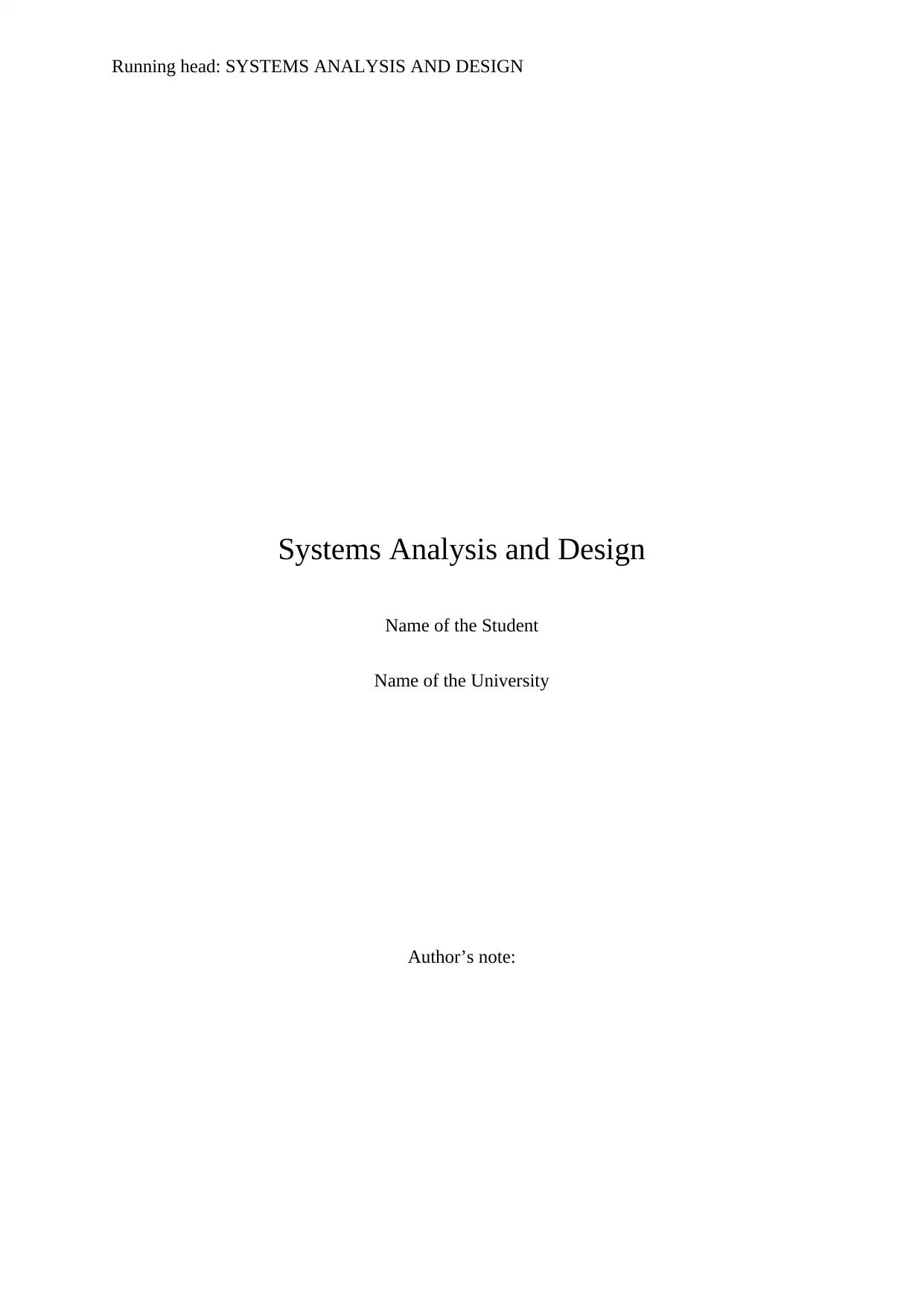
Running head: SYSTEMS ANALYSIS AND DESIGN
Systems Analysis and Design
Name of the Student
Name of the University
Author’s note:
Systems Analysis and Design
Name of the Student
Name of the University
Author’s note:
Secure Best Marks with AI Grader
Need help grading? Try our AI Grader for instant feedback on your assignments.
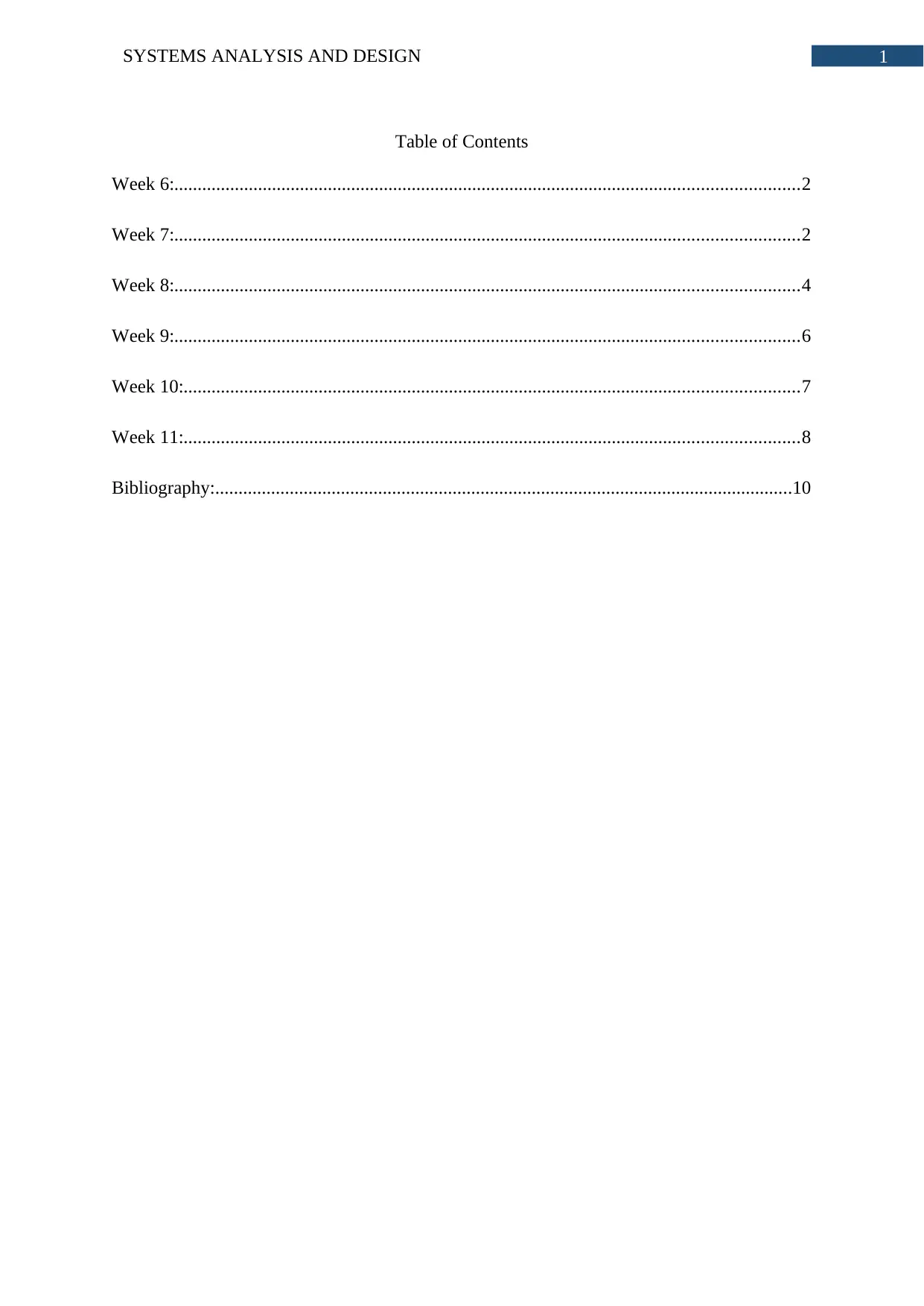
1SYSTEMS ANALYSIS AND DESIGN
Table of Contents
Week 6:......................................................................................................................................2
Week 7:......................................................................................................................................2
Week 8:......................................................................................................................................4
Week 9:......................................................................................................................................6
Week 10:....................................................................................................................................7
Week 11:....................................................................................................................................8
Bibliography:............................................................................................................................10
Table of Contents
Week 6:......................................................................................................................................2
Week 7:......................................................................................................................................2
Week 8:......................................................................................................................................4
Week 9:......................................................................................................................................6
Week 10:....................................................................................................................................7
Week 11:....................................................................................................................................8
Bibliography:............................................................................................................................10

2SYSTEMS ANALYSIS AND DESIGN
Week 6:
Answer to Question 1: The HIPPA puts some rules and regulation on the operations
of RTGM regarding the handling of the patient health data. The HIPPA has a list of
regulations that RTGM has to follow in its lifecycle. As the HIPPA is approved and
maintained by the government it is mandatory to follow.
Answer to Question 2: The encryption is the method that can applied to make the data
secure during transmission from mobile to the system. The encryption approach will encrypt
the data into ciphers and the system server will decrypt the cipher to get the real data.
Answer to Question 3: The first approach can be using a pattern lock mechanism
specially designed for the application. The second and subsequent approach is encrypting the
data stored in mobile so that hackers cannot physically access the data.
Answer to Question 4: The best solution will be using cloud solution for the
application. The mobile will not be responsible or any computation or storage operations.
Only the interface and basic operations will be installed. The system will be hardware
specific such as MAC address will be same as registered.
Answer to Question 5: The wired communication has limited accessibility. The
system can be accessed within a small range of area. The wireless is on the other hand has
connection issue. The wireless connection is more vulnerable.
Week 7:
Objects: The objects of the car buying scenario are buyer, car, type, order, invoice,
payment and payment type.
Week 6:
Answer to Question 1: The HIPPA puts some rules and regulation on the operations
of RTGM regarding the handling of the patient health data. The HIPPA has a list of
regulations that RTGM has to follow in its lifecycle. As the HIPPA is approved and
maintained by the government it is mandatory to follow.
Answer to Question 2: The encryption is the method that can applied to make the data
secure during transmission from mobile to the system. The encryption approach will encrypt
the data into ciphers and the system server will decrypt the cipher to get the real data.
Answer to Question 3: The first approach can be using a pattern lock mechanism
specially designed for the application. The second and subsequent approach is encrypting the
data stored in mobile so that hackers cannot physically access the data.
Answer to Question 4: The best solution will be using cloud solution for the
application. The mobile will not be responsible or any computation or storage operations.
Only the interface and basic operations will be installed. The system will be hardware
specific such as MAC address will be same as registered.
Answer to Question 5: The wired communication has limited accessibility. The
system can be accessed within a small range of area. The wireless is on the other hand has
connection issue. The wireless connection is more vulnerable.
Week 7:
Objects: The objects of the car buying scenario are buyer, car, type, order, invoice,
payment and payment type.
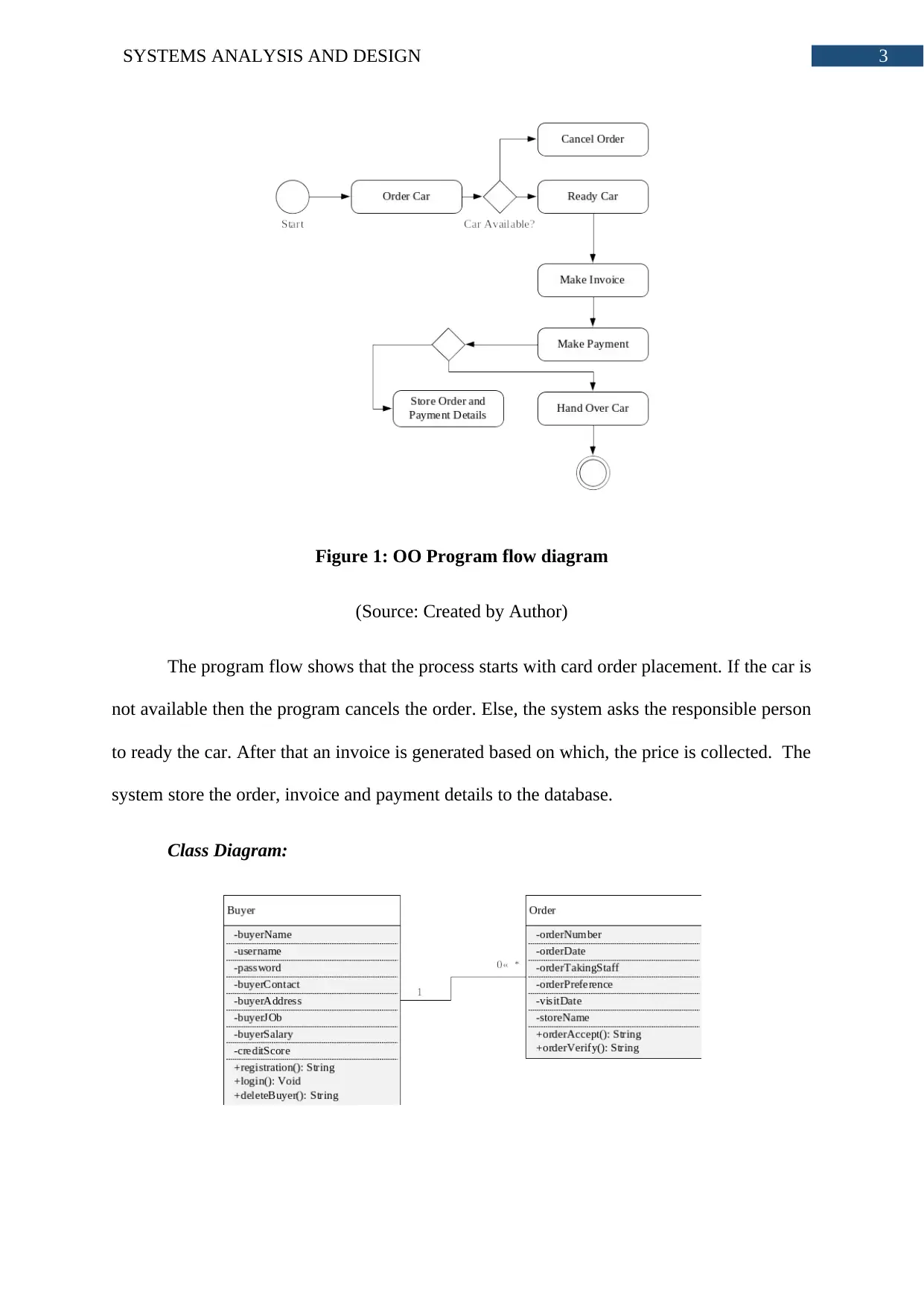
3SYSTEMS ANALYSIS AND DESIGN
Figure 1: OO Program flow diagram
(Source: Created by Author)
The program flow shows that the process starts with card order placement. If the car is
not available then the program cancels the order. Else, the system asks the responsible person
to ready the car. After that an invoice is generated based on which, the price is collected. The
system store the order, invoice and payment details to the database.
Class Diagram:
Figure 1: OO Program flow diagram
(Source: Created by Author)
The program flow shows that the process starts with card order placement. If the car is
not available then the program cancels the order. Else, the system asks the responsible person
to ready the car. After that an invoice is generated based on which, the price is collected. The
system store the order, invoice and payment details to the database.
Class Diagram:
Secure Best Marks with AI Grader
Need help grading? Try our AI Grader for instant feedback on your assignments.
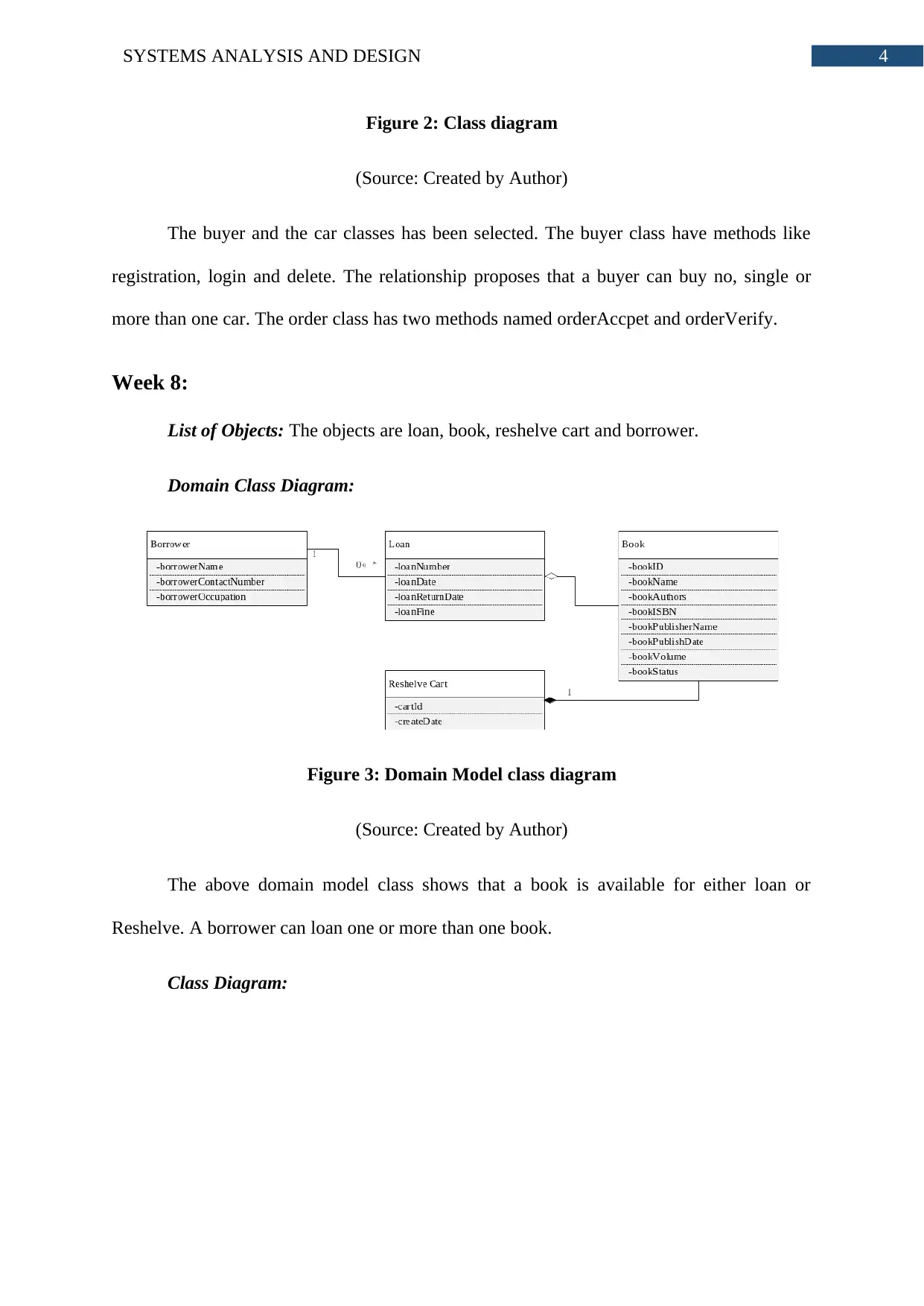
4SYSTEMS ANALYSIS AND DESIGN
Figure 2: Class diagram
(Source: Created by Author)
The buyer and the car classes has been selected. The buyer class have methods like
registration, login and delete. The relationship proposes that a buyer can buy no, single or
more than one car. The order class has two methods named orderAccpet and orderVerify.
Week 8:
List of Objects: The objects are loan, book, reshelve cart and borrower.
Domain Class Diagram:
Figure 3: Domain Model class diagram
(Source: Created by Author)
The above domain model class shows that a book is available for either loan or
Reshelve. A borrower can loan one or more than one book.
Class Diagram:
Figure 2: Class diagram
(Source: Created by Author)
The buyer and the car classes has been selected. The buyer class have methods like
registration, login and delete. The relationship proposes that a buyer can buy no, single or
more than one car. The order class has two methods named orderAccpet and orderVerify.
Week 8:
List of Objects: The objects are loan, book, reshelve cart and borrower.
Domain Class Diagram:
Figure 3: Domain Model class diagram
(Source: Created by Author)
The above domain model class shows that a book is available for either loan or
Reshelve. A borrower can loan one or more than one book.
Class Diagram:
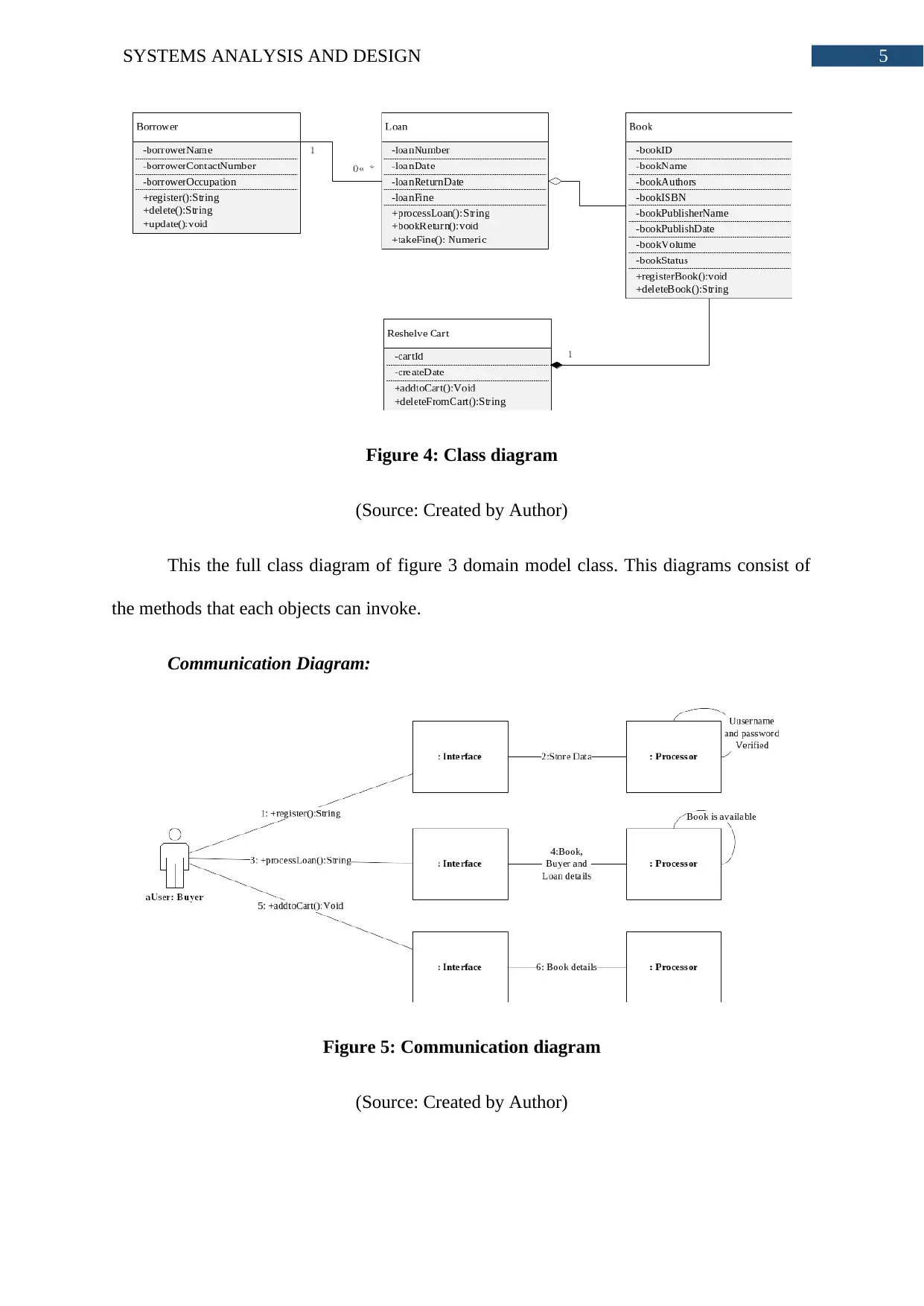
5SYSTEMS ANALYSIS AND DESIGN
Figure 4: Class diagram
(Source: Created by Author)
This the full class diagram of figure 3 domain model class. This diagrams consist of
the methods that each objects can invoke.
Communication Diagram:
Figure 5: Communication diagram
(Source: Created by Author)
Figure 4: Class diagram
(Source: Created by Author)
This the full class diagram of figure 3 domain model class. This diagrams consist of
the methods that each objects can invoke.
Communication Diagram:
Figure 5: Communication diagram
(Source: Created by Author)
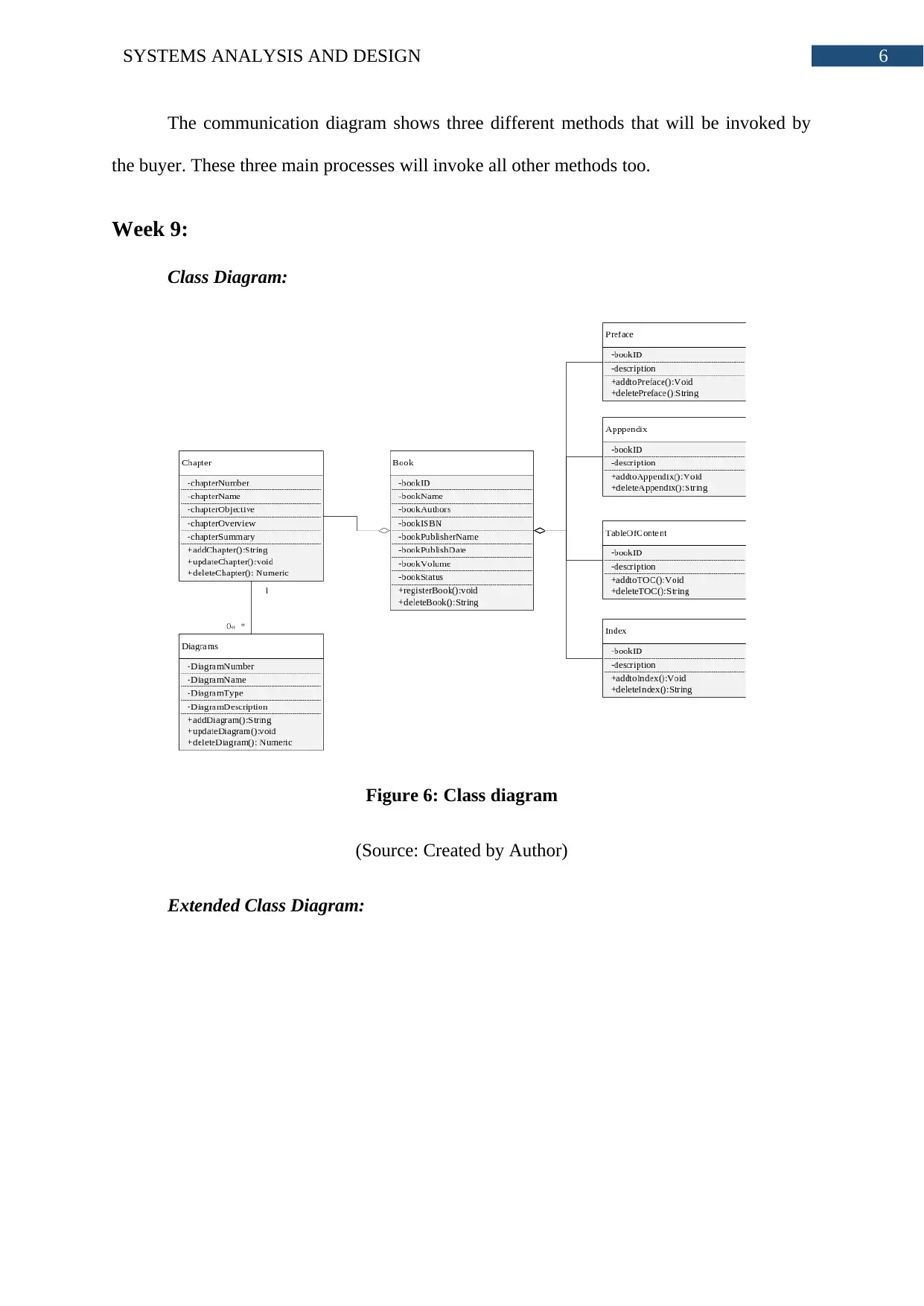
6SYSTEMS ANALYSIS AND DESIGN
The communication diagram shows three different methods that will be invoked by
the buyer. These three main processes will invoke all other methods too.
Week 9:
Class Diagram:
Figure 6: Class diagram
(Source: Created by Author)
Extended Class Diagram:
The communication diagram shows three different methods that will be invoked by
the buyer. These three main processes will invoke all other methods too.
Week 9:
Class Diagram:
Figure 6: Class diagram
(Source: Created by Author)
Extended Class Diagram:
Paraphrase This Document
Need a fresh take? Get an instant paraphrase of this document with our AI Paraphraser
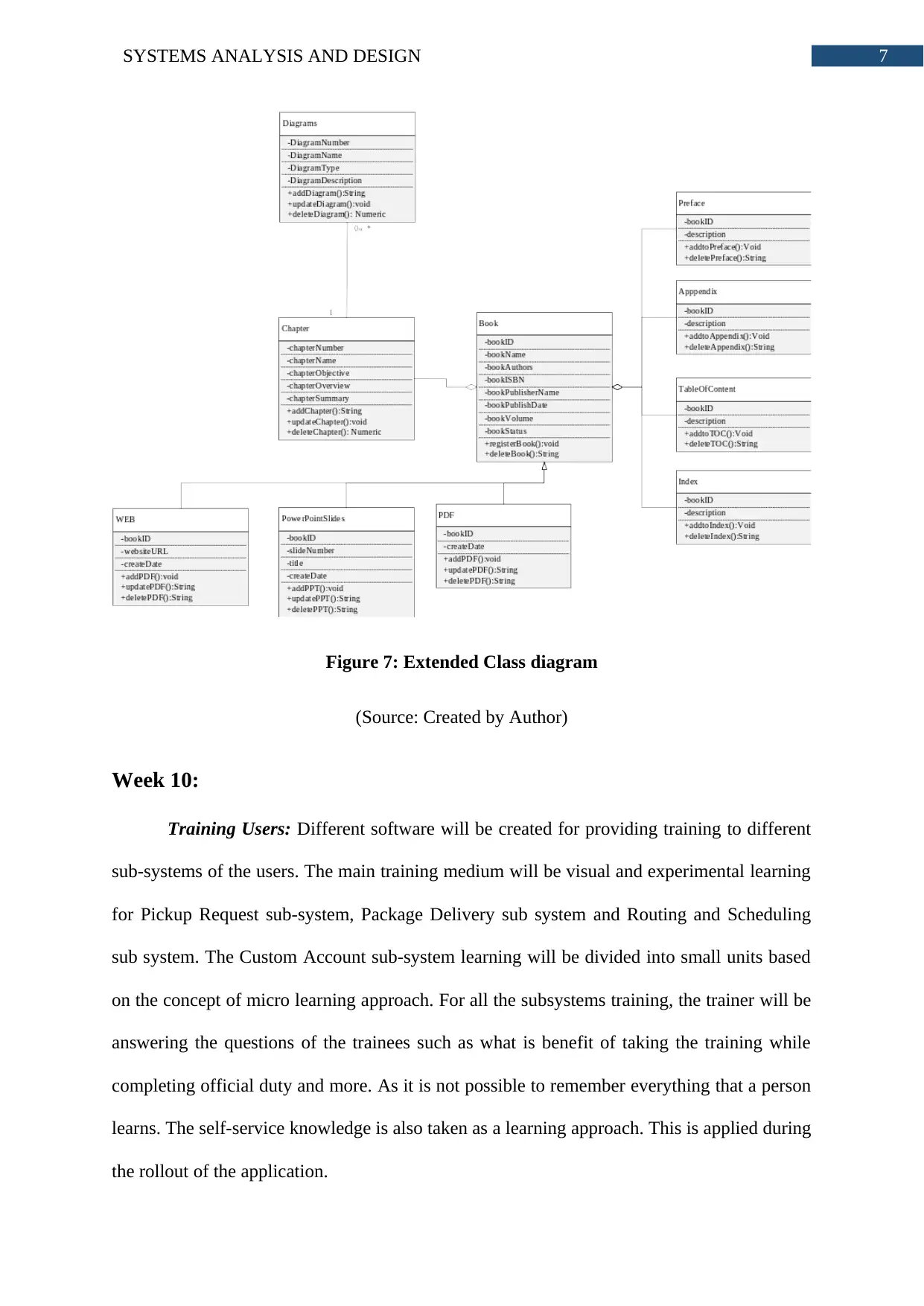
7SYSTEMS ANALYSIS AND DESIGN
Figure 7: Extended Class diagram
(Source: Created by Author)
Week 10:
Training Users: Different software will be created for providing training to different
sub-systems of the users. The main training medium will be visual and experimental learning
for Pickup Request sub-system, Package Delivery sub system and Routing and Scheduling
sub system. The Custom Account sub-system learning will be divided into small units based
on the concept of micro learning approach. For all the subsystems training, the trainer will be
answering the questions of the trainees such as what is benefit of taking the training while
completing official duty and more. As it is not possible to remember everything that a person
learns. The self-service knowledge is also taken as a learning approach. This is applied during
the rollout of the application.
Figure 7: Extended Class diagram
(Source: Created by Author)
Week 10:
Training Users: Different software will be created for providing training to different
sub-systems of the users. The main training medium will be visual and experimental learning
for Pickup Request sub-system, Package Delivery sub system and Routing and Scheduling
sub system. The Custom Account sub-system learning will be divided into small units based
on the concept of micro learning approach. For all the subsystems training, the trainer will be
answering the questions of the trainees such as what is benefit of taking the training while
completing official duty and more. As it is not possible to remember everything that a person
learns. The self-service knowledge is also taken as a learning approach. This is applied during
the rollout of the application.
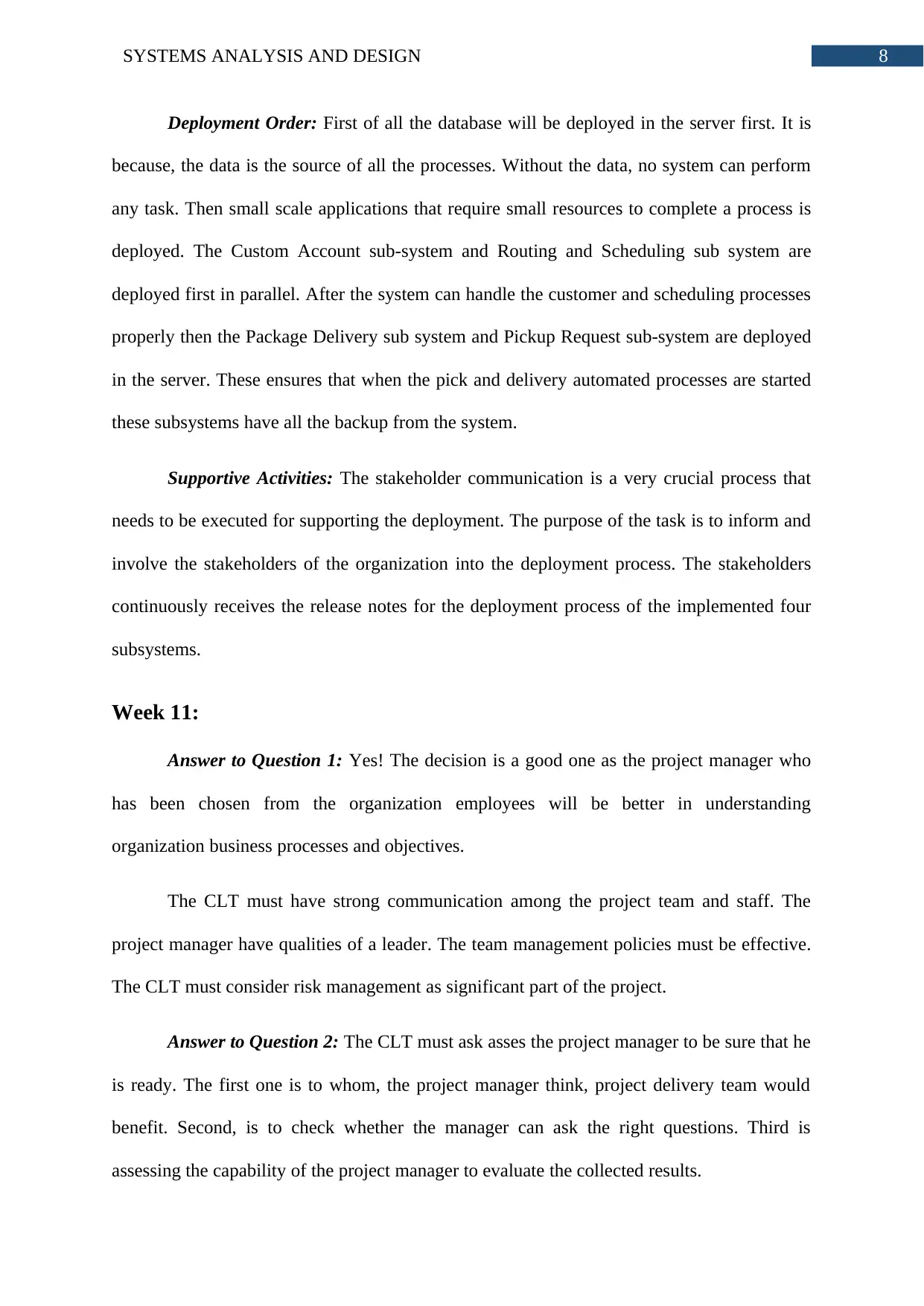
8SYSTEMS ANALYSIS AND DESIGN
Deployment Order: First of all the database will be deployed in the server first. It is
because, the data is the source of all the processes. Without the data, no system can perform
any task. Then small scale applications that require small resources to complete a process is
deployed. The Custom Account sub-system and Routing and Scheduling sub system are
deployed first in parallel. After the system can handle the customer and scheduling processes
properly then the Package Delivery sub system and Pickup Request sub-system are deployed
in the server. These ensures that when the pick and delivery automated processes are started
these subsystems have all the backup from the system.
Supportive Activities: The stakeholder communication is a very crucial process that
needs to be executed for supporting the deployment. The purpose of the task is to inform and
involve the stakeholders of the organization into the deployment process. The stakeholders
continuously receives the release notes for the deployment process of the implemented four
subsystems.
Week 11:
Answer to Question 1: Yes! The decision is a good one as the project manager who
has been chosen from the organization employees will be better in understanding
organization business processes and objectives.
The CLT must have strong communication among the project team and staff. The
project manager have qualities of a leader. The team management policies must be effective.
The CLT must consider risk management as significant part of the project.
Answer to Question 2: The CLT must ask asses the project manager to be sure that he
is ready. The first one is to whom, the project manager think, project delivery team would
benefit. Second, is to check whether the manager can ask the right questions. Third is
assessing the capability of the project manager to evaluate the collected results.
Deployment Order: First of all the database will be deployed in the server first. It is
because, the data is the source of all the processes. Without the data, no system can perform
any task. Then small scale applications that require small resources to complete a process is
deployed. The Custom Account sub-system and Routing and Scheduling sub system are
deployed first in parallel. After the system can handle the customer and scheduling processes
properly then the Package Delivery sub system and Pickup Request sub-system are deployed
in the server. These ensures that when the pick and delivery automated processes are started
these subsystems have all the backup from the system.
Supportive Activities: The stakeholder communication is a very crucial process that
needs to be executed for supporting the deployment. The purpose of the task is to inform and
involve the stakeholders of the organization into the deployment process. The stakeholders
continuously receives the release notes for the deployment process of the implemented four
subsystems.
Week 11:
Answer to Question 1: Yes! The decision is a good one as the project manager who
has been chosen from the organization employees will be better in understanding
organization business processes and objectives.
The CLT must have strong communication among the project team and staff. The
project manager have qualities of a leader. The team management policies must be effective.
The CLT must consider risk management as significant part of the project.
Answer to Question 2: The CLT must ask asses the project manager to be sure that he
is ready. The first one is to whom, the project manager think, project delivery team would
benefit. Second, is to check whether the manager can ask the right questions. Third is
assessing the capability of the project manager to evaluate the collected results.
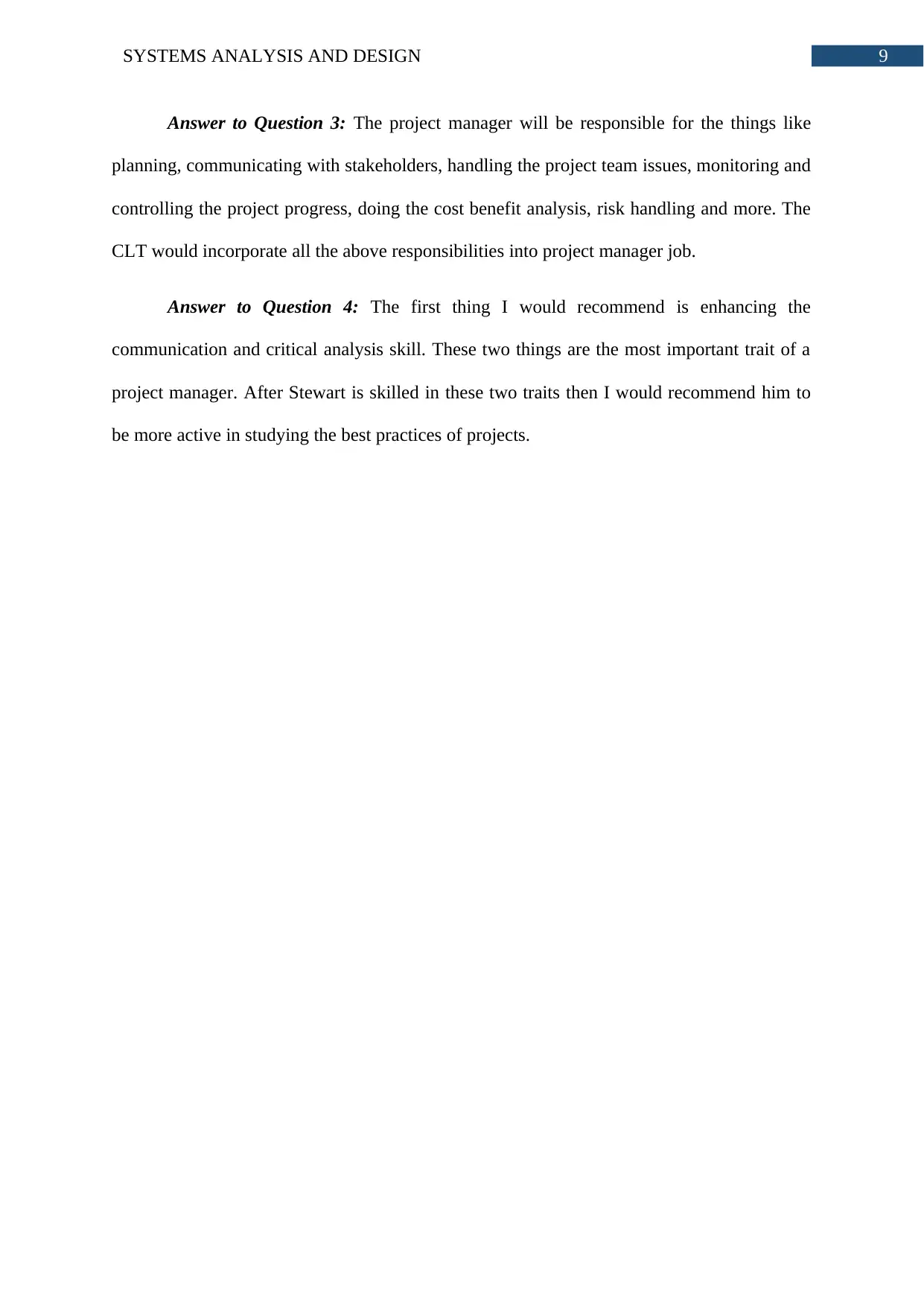
9SYSTEMS ANALYSIS AND DESIGN
Answer to Question 3: The project manager will be responsible for the things like
planning, communicating with stakeholders, handling the project team issues, monitoring and
controlling the project progress, doing the cost benefit analysis, risk handling and more. The
CLT would incorporate all the above responsibilities into project manager job.
Answer to Question 4: The first thing I would recommend is enhancing the
communication and critical analysis skill. These two things are the most important trait of a
project manager. After Stewart is skilled in these two traits then I would recommend him to
be more active in studying the best practices of projects.
Answer to Question 3: The project manager will be responsible for the things like
planning, communicating with stakeholders, handling the project team issues, monitoring and
controlling the project progress, doing the cost benefit analysis, risk handling and more. The
CLT would incorporate all the above responsibilities into project manager job.
Answer to Question 4: The first thing I would recommend is enhancing the
communication and critical analysis skill. These two things are the most important trait of a
project manager. After Stewart is skilled in these two traits then I would recommend him to
be more active in studying the best practices of projects.
Secure Best Marks with AI Grader
Need help grading? Try our AI Grader for instant feedback on your assignments.
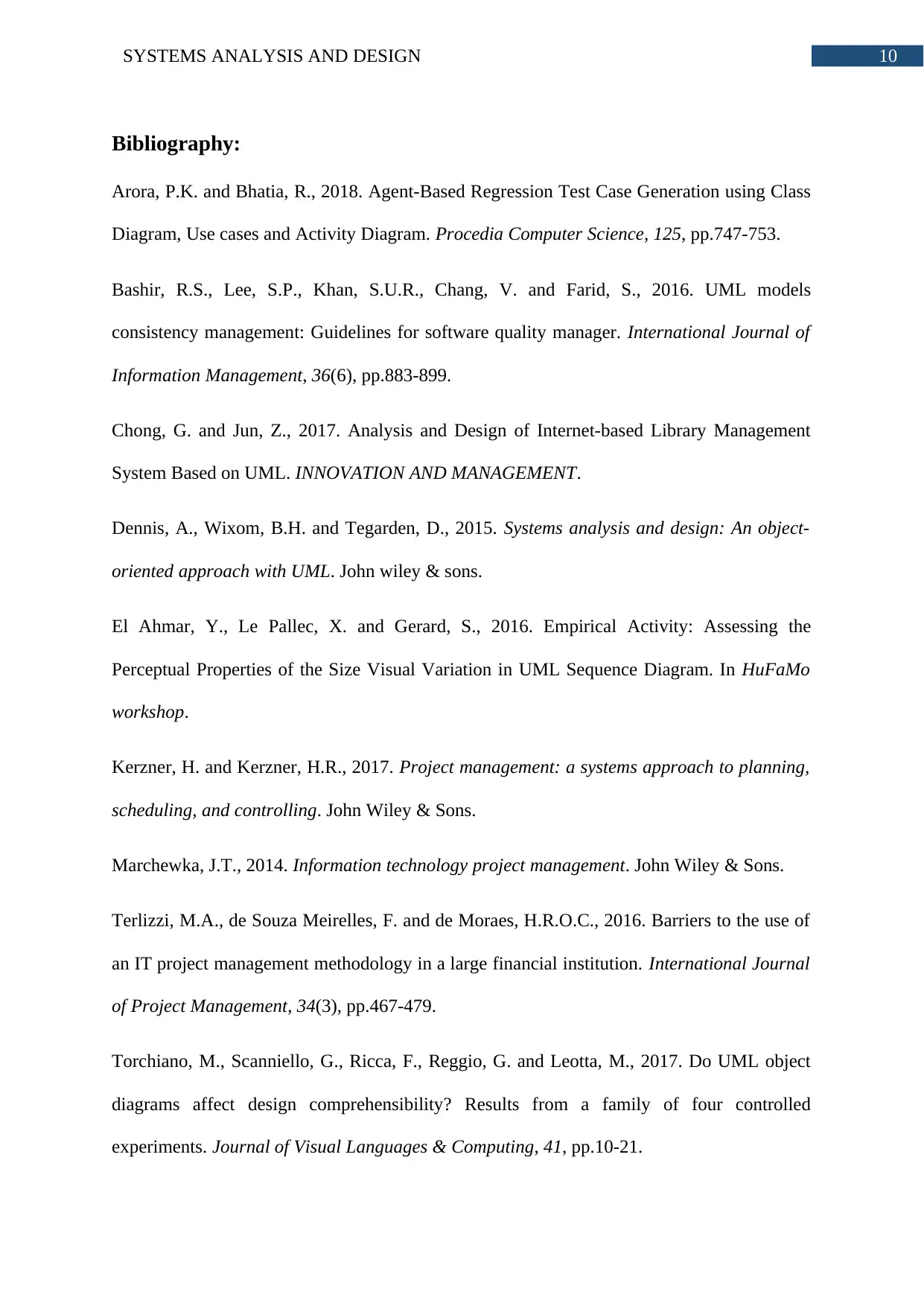
10SYSTEMS ANALYSIS AND DESIGN
Bibliography:
Arora, P.K. and Bhatia, R., 2018. Agent-Based Regression Test Case Generation using Class
Diagram, Use cases and Activity Diagram. Procedia Computer Science, 125, pp.747-753.
Bashir, R.S., Lee, S.P., Khan, S.U.R., Chang, V. and Farid, S., 2016. UML models
consistency management: Guidelines for software quality manager. International Journal of
Information Management, 36(6), pp.883-899.
Chong, G. and Jun, Z., 2017. Analysis and Design of Internet-based Library Management
System Based on UML. INNOVATION AND MANAGEMENT.
Dennis, A., Wixom, B.H. and Tegarden, D., 2015. Systems analysis and design: An object-
oriented approach with UML. John wiley & sons.
El Ahmar, Y., Le Pallec, X. and Gerard, S., 2016. Empirical Activity: Assessing the
Perceptual Properties of the Size Visual Variation in UML Sequence Diagram. In HuFaMo
workshop.
Kerzner, H. and Kerzner, H.R., 2017. Project management: a systems approach to planning,
scheduling, and controlling. John Wiley & Sons.
Marchewka, J.T., 2014. Information technology project management. John Wiley & Sons.
Terlizzi, M.A., de Souza Meirelles, F. and de Moraes, H.R.O.C., 2016. Barriers to the use of
an IT project management methodology in a large financial institution. International Journal
of Project Management, 34(3), pp.467-479.
Torchiano, M., Scanniello, G., Ricca, F., Reggio, G. and Leotta, M., 2017. Do UML object
diagrams affect design comprehensibility? Results from a family of four controlled
experiments. Journal of Visual Languages & Computing, 41, pp.10-21.
Bibliography:
Arora, P.K. and Bhatia, R., 2018. Agent-Based Regression Test Case Generation using Class
Diagram, Use cases and Activity Diagram. Procedia Computer Science, 125, pp.747-753.
Bashir, R.S., Lee, S.P., Khan, S.U.R., Chang, V. and Farid, S., 2016. UML models
consistency management: Guidelines for software quality manager. International Journal of
Information Management, 36(6), pp.883-899.
Chong, G. and Jun, Z., 2017. Analysis and Design of Internet-based Library Management
System Based on UML. INNOVATION AND MANAGEMENT.
Dennis, A., Wixom, B.H. and Tegarden, D., 2015. Systems analysis and design: An object-
oriented approach with UML. John wiley & sons.
El Ahmar, Y., Le Pallec, X. and Gerard, S., 2016. Empirical Activity: Assessing the
Perceptual Properties of the Size Visual Variation in UML Sequence Diagram. In HuFaMo
workshop.
Kerzner, H. and Kerzner, H.R., 2017. Project management: a systems approach to planning,
scheduling, and controlling. John Wiley & Sons.
Marchewka, J.T., 2014. Information technology project management. John Wiley & Sons.
Terlizzi, M.A., de Souza Meirelles, F. and de Moraes, H.R.O.C., 2016. Barriers to the use of
an IT project management methodology in a large financial institution. International Journal
of Project Management, 34(3), pp.467-479.
Torchiano, M., Scanniello, G., Ricca, F., Reggio, G. and Leotta, M., 2017. Do UML object
diagrams affect design comprehensibility? Results from a family of four controlled
experiments. Journal of Visual Languages & Computing, 41, pp.10-21.

11SYSTEMS ANALYSIS AND DESIGN
1 out of 12
Your All-in-One AI-Powered Toolkit for Academic Success.
+13062052269
info@desklib.com
Available 24*7 on WhatsApp / Email
![[object Object]](/_next/static/media/star-bottom.7253800d.svg)
Unlock your academic potential
© 2024 | Zucol Services PVT LTD | All rights reserved.



